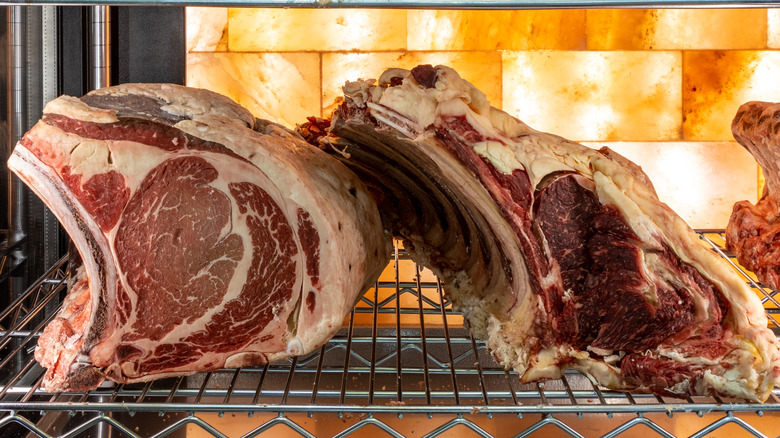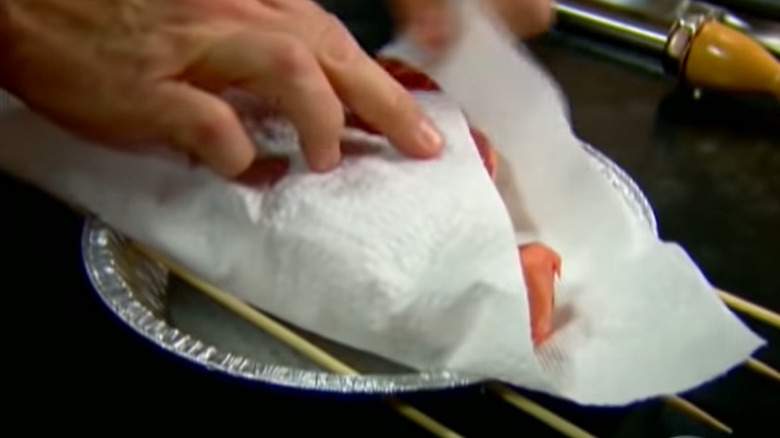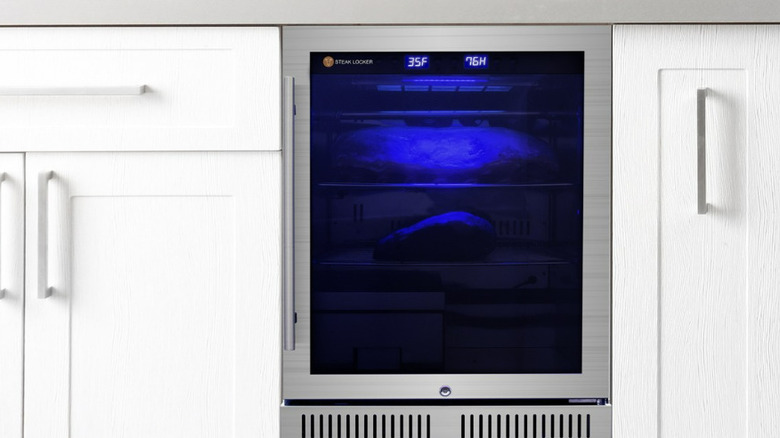Mimic Dry-Aged Steak At Home With 3 Common Kitchen Items
Not all consumables get better with age, but wine, cheese, and sourdough starters sure do. Each one benefits from the intensification of flavor bestowed by controlled microbial activity and inevitable evaporation. And then there's steak, which, in addition to all that, develops an alluringly tender bite as the aging process breaks down muscle fibers and connective tissue.
What makes dry-aged steak unique, among other things, is how wonderfully the aging process works its special brand of magic on high-end, highly marbleized (i.e., richly fatty) meats such as ribeye and porterhouse. That, along with the considerable food waste involved in the commercial dry aging process, figures into dry-aged beef's significantly higher price tag. If only there were a way to dry-age steak at home, right? Wouldn't that address both waste and price, not to mention ready accessibility?
The answer is complicated, however. The sublime cuts of dry-aged beef available from top-of-the-line steakhouses have been aged for anywhere from two weeks to two months in spaces carefully controlled for humidity, temperature, and airflow. Moreover, they inevitably begin with enormous portions that are thickly insulated by bone and/or layers of fat.
So, as a technical matter, most home cooks won't be able to dry age their own steaks, as celebrity chef, Alton Brown has noted. Nevertheless, Brown has come up with a way to mimic the whole dry-aging process at home, and you'll only need three common kitchen items and a few pro tips to pull it off.
The low stakes route to dry aging steak at home
A small number of steak-obsessed foodies have the facilities and physical wherewithal to handle dry-aging large primal cuts of beef at home. For this privileged few, the advice of professional butcher Katie Flannery is to let them age for up to 35 days to truly bring in the nose, not to mention the funk, associated with professionally dry-aged steak (via Robb Report). But Alton Brown's home-kitchen approximation of dry aging steak can be accomplished in a matter of four days.
To set up your own homegrown dry aging operation, you'll need only three common items that you may well already have in your kitchen. The first is a roll of paper towels, preferably a kind made with minimal exposure to dyes and other chemicals since you'll be wrapping your steak in these paper towels during your dry-aging mimicry. The second is a foil pie tin, which will hopefully be large enough to accommodate the surface area of your steak. If not, try a foil broiling pan. The third is a number of wooden skewers, which you'll use to poke through opposite sides of your foil vessel to create a platform on which your paper-wrapped steak will reside as it dry-ages.
Place this whole Rube Goldberg-like contraption into your fridge for four days. The ideal spot is one with plenty of airflow but not much hand traffic. Change out the paper towel every 24 hours.
Pro-tips to keep in mind when mimicking dry-aged steak at home
While this process is pretty straightforward, there are a few negatives of this ttechniquee that you should consider before getting started. First, dry aging involves various chemical reactions, according to a 2016 paper published in the Journal of Animal Science and Technology. These reactions inevitably result in meaty and yeasty off-odors. As much as you may embrace the end result — i.e., a sublimely dry-aged steak — those developing aromas may not agree with you or other members of your household when opening the refrigerator.
Moreover, every time you swing open that refrigerator door, you change the ambient temperature and humidity level, even if only marginally. Perhaps most concerningly, however, every time you or anyone else reaches into that fridge, it poses some risk of cross-contamination, whether via contact with one's skin or with particles or droplets from other foods and/or beverages.
As such, if you're considering making use of Brown's home fridge "dry-aging" technique, then you might want to consider doing so at a time when your refrigerator will have minimal (though ideally zero) other uses. Alternatively, you might consider using a spare refrigerator if you happen to have one. Even a college dorm-sized mini-fridge will work for this purpose. Additionally, it's best if you can control the temperature of your fridge, and keep it set between 32 and 39.2 degrees Fahrenheit, according to the 2016 paper. Ideally, you'll also be able to maintain the ambient humidity at 61–85%. Lower than that, you run the risk of dried-out meat. Higher than that, you run the risk of unwanted bacterial growth.
As you can see while Alton Brown's method is straightforward, creating the ideal environment and conditions certainly isn't easy. If you're up for a challenge though, it could ccertainly be worth the effort!


